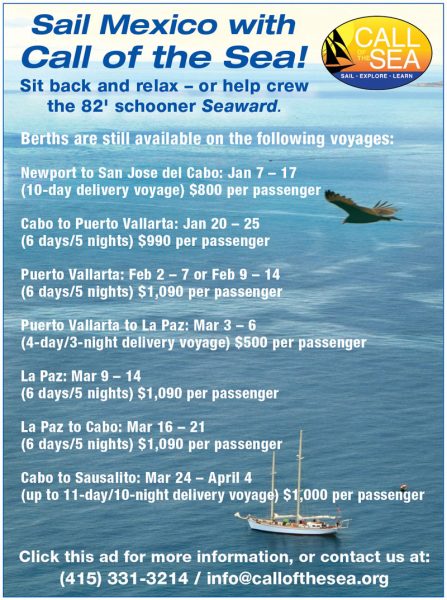
Tuning into the Rolex Sydney Hobart
Armchair Racing
When we say “armchair racing,” you might picture scooting armchairs around the living room in an attempt to be the first to the holiday gifts. Although that’s an amusing visual, this is something to divert your attention when you’ve had a bit of holiday overload and are ready for a yachty distraction. The Rolex Sydney Hobart Race will start conveniently on Boxing Day, December 26. Because Australia’s so far ahead of us, it will still be Christmas Day here in the States.
Boats to Watch
The 170 boats entered this 75th edition include five super-maxis: Peter Harburg’s Black Jack, Jim Cooney and Samantha Grant’s record holder Comanche, Christian Beck’s InfoTrack, the Oatley family’s reigning line-honors champion Wild Oats XI, and Seng Huang Lee’s SHK Scallywag from Hong Kong. Stan Honey of Palo Alto will again serve aboard the Cooney family’s Comanche.
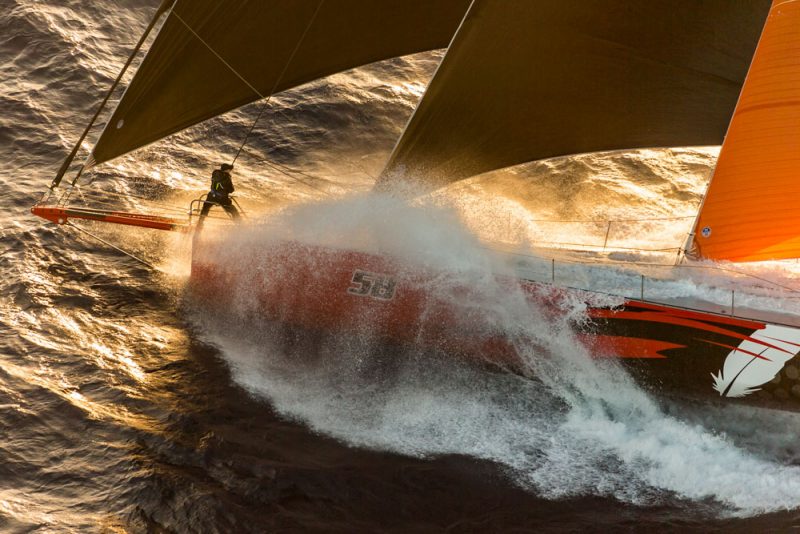
Among a few first-timers, the most notable is the first Aboriginal crew to ever take part in the race with the Beneteau 47.7 Tribal Warrior.
The only American entry is Cailin Lomhara (Irish Gaelic meaning “Precious Girl”), Lawrence Green’s 1999 Tayana 52, a cruiser with 53,000 miles under her keel.
Major Repairs in the Nick of Time
Wild Oats XI almost didn’t make it. The R/P 100 has claimed line honors nine times, won on corrected time twice, and set the record twice. But she suffered major structural damage a little more than a month ago. Her carbon fiber mast fractured at deck level, causing a large part of the deck structure to fail.
The damage occurred during a 180-mile race out of Sydney. The crew managed to stabilize the broken mast and reach shore before the yacht suffered any additional damage. So, during the past five weeks, the boat has undergone a major rebuild at its dock in Sydney.
Another Boat to Watch
Paddy, Melinda and Keith Broughton’s 76-ft S&S yawl Kialoa II took line honors in the 1971 Sydney Hobart. Fashioned of lightweight aluminum and commissioned by Californian Jim Kilroy, Kialoa II was a cutting-edge yacht at the time. This year’s RSH follows Kialoa II’s race to Hawaii in the 50th edition of the Transpac in July. Kialoa II isn’t the one that graced San Francisco Bay with her presence in the 2015 Rolex Big Boat Series. That was Kialoa III, an S&S 78, also part of Kilroy’s five-boat Kialoa series. “Kialoa” is Hawaiian for “long white canoe.”
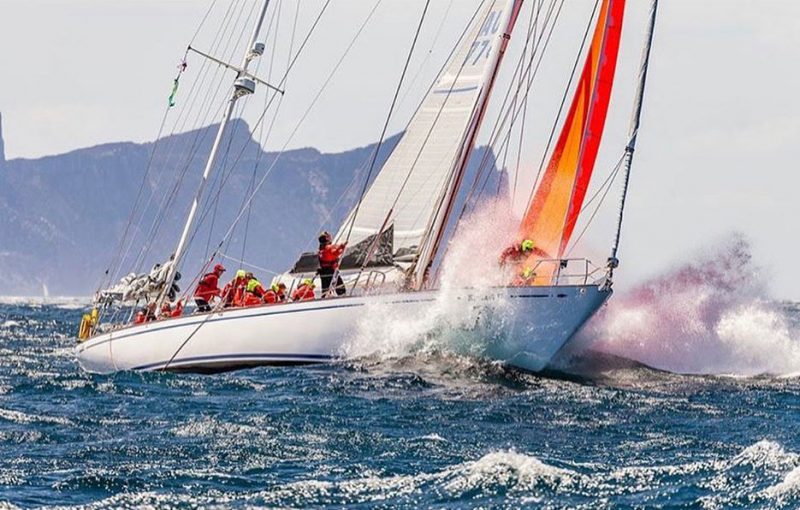
Forecast for Fires and Weather
Much like California at certain times of year, the weather reports for southeastern Australia have been heavy on smoke and haze from ongoing wildfires ( called “bush” fires in Australia). “With all the smoke haze and whatever, that’s impacting the weather models quite a lot,” said Ichi Ban skipper Matt Allen. “All the racing we’ve done, September, October and November, the weather just hasn’t correlated with the forecasting at all.”
Nevertheless, the Bureau of Meteorology’s early forecast, released by the RSH folks Thursday, predicts clear, smoke-free skies for the start.
How to Watch the Race
The warning signal will be fired at 12:50 p.m. local time on December 26. That translates to 5:50 p.m. PST on December 25. You can watch a webcast of the live broadcast on the home page of the event website at www.rolexsydneyhobart.com. If you miss the start, you can catch a replay on the site too. Of course, all the boats will carry trackers, so you can check on them during the race at www.rolexsydneyhobart.com/tracker.
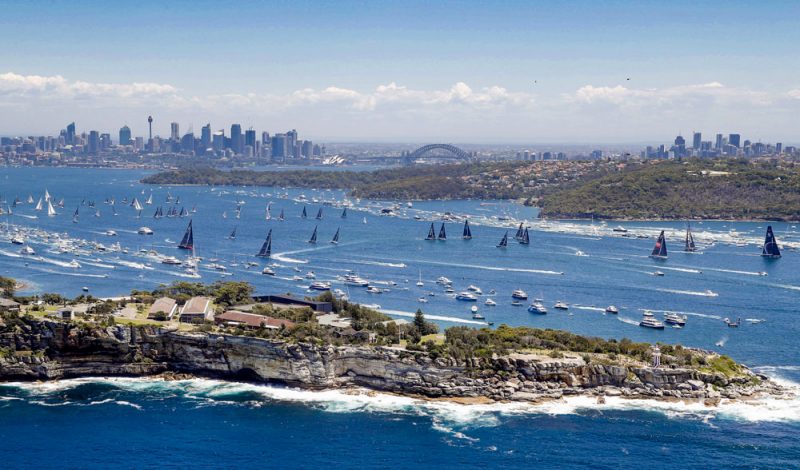
Virtual Regatta
Gamers can sail the 628-mile race in real time, using current weather data and their best navigational skills. In 2018, Eagle Black TPN was the eventual winner, in 2 days, 21 hours, 54 minutes. Who will win in 2019?
The Virtual Regatta can be accessed from a PC, Mac or mobile device. Go to virtualregatta.com, rolexsydneyhobart.com or your favorite app store. Sign up for free, then set up your boat and select your sails.
Latitude Nation: What’ve You Been DIY-ing Lately?
Like the arrival of the rain, the setting of the sun and the rotation of planets, so too comes work on the boat. The project may be something you’ve been meaning to do, or something that broke on your last sail. Maybe you’ve contemplated hiring someone to do the job, but maybe you’re a brave soul and you’ve decided to Do It Yourself.
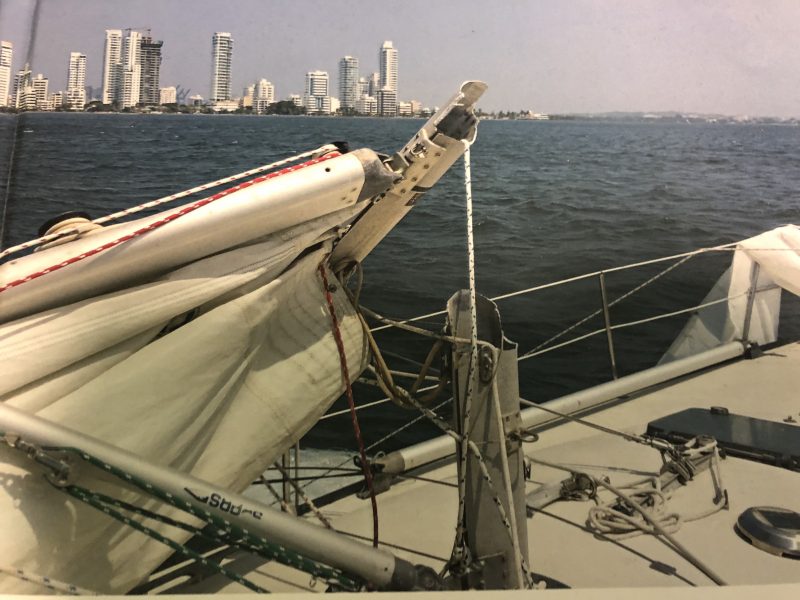
We’d like to know what DIY project you have going out there, or something that you’ve done recently — within the last year-ish — that you’re especially proud of. We’d also like to know if there are any projects that have you perplexed. Could you benefit from a how-to article?
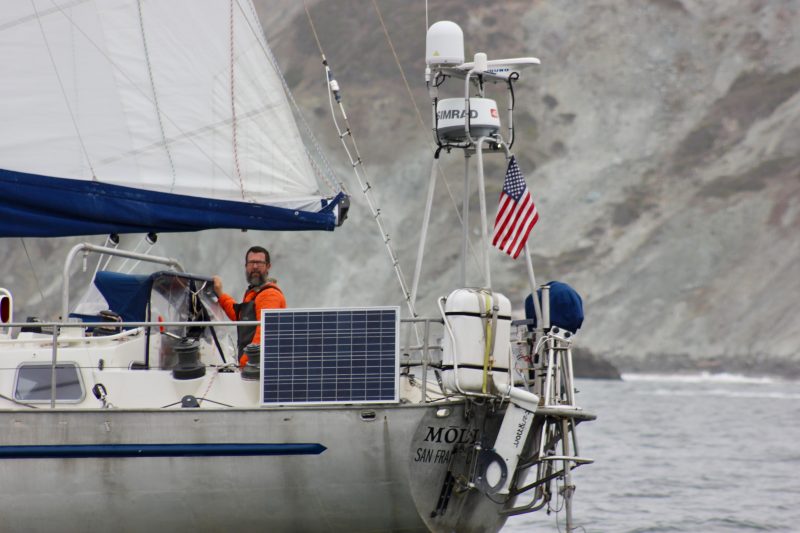
While those of us in Northern California are blessed with mild winters, the rain, cold and short days can still be a factor in making sailors say, “I’ll get to that project in the spring.” Are you a hibernating DIYer, or are you an all-season DIYer?
Based on your responses, we hope to put together an article in the coming weeks and months. Please comment below, or send your responses here. Pictures are always appreciated. We will also have the next installment in Joshua Wheeler’s Resourceful Sailor Series in the near future.
Happy DIY-ing!
Sail Mexico with Call of the Sea
Saved by Easom and the Army Corps of Engineers
The Yacht Racing Association (YRA) organizes and runs races each year, including an ocean series, four destination regattas, and a series of races on the Bay. Each race sends sailors around a set of buoys. The Coast Guard maintains all the buoys on the ocean and the commercial navigation buoys on the Bay. There are also a set of buoys that are owned and maintained by the YRA. They’re used extensively by the YRA and Bay Area yacht clubs for races.
Buoys, whether on the ocean or the Bay, are ravaged by big tidal flows, big waves and occasional bumps by boats large and small, and sit in a corrosive saltwater environment. The combination of forces exerted on buoys means that they are sometimes dislodged from their positions, sometimes to be found lying on a Bay shore or sometimes never seen again. It’s a big project for the YRA to maintain these buoys.
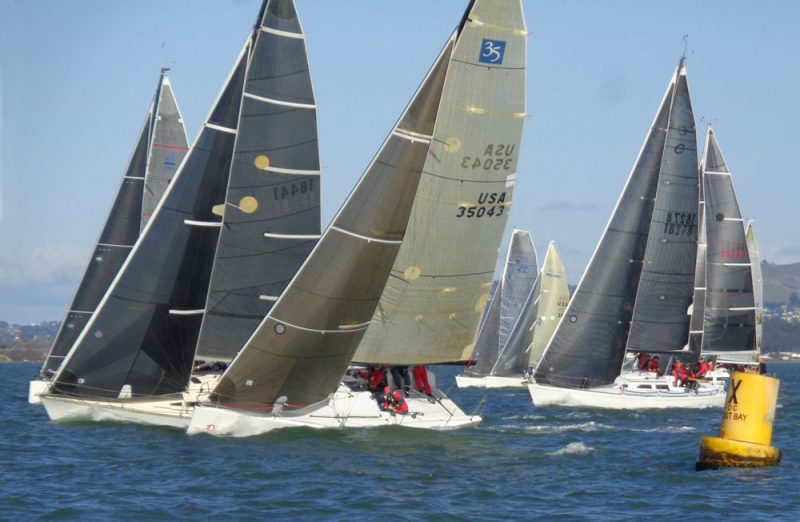
In recent years, #16 (Blackaller), #6 (Fort Mason), #4 (Knox), XOC (Berkeley Circle’s center pin), and X (Golden Gate YC) have all decided to go on a walkabout. Blackaller and #16 were replaced in 2018. Fort Mason has been a particularly difficult buoy to keep on station. In the past four years the buoy has disappeared three times. The last #4 buoy to be replaced disappeared one week after it was set. The new buoy has a solar-powered light, which seems to have helped the buoy survive or avoid whatever mistreatment was visited upon the buoy in the past.
This fall, #4, XOC, FOC, GOC, and X were replaced. Knox disappeared and XOC and X washed up on various Bay Area shores in the weeks following their disappearance. Knox was replaced with a brand-new red nun buoy.
The YRA is always looking for ways to manage the cost of maintaining, rigging and setting new buoys on the Bay, which can cost several thousand dollars a year. The challenges included finding a rigger who could handle a buoy and rigging often weighing several hundred pounds, and finding a boat that could deploy the large and heavy buoys.
Recently, we’ve had the good fortune of being helped in our buoy endeavors by Easom Rigging and the Army Corps of Engineers. Scott Easom has been instrumental in rigging our new buoys with upgraded chain and anchors and adding lights to all new buoys. The Army Corps of Engineers has been particularly helpful in setting the new marks. Captain Kixon Meyer of the Army Corps of Engineers crew has been remarkable in maneuvering his catamaran into very tight spaces to pick up the new buoys with heavy chain and anchors and then setting the buoys on their stations using GPS coordinates. This is all the more impressive when you consider that a buoy with its accompanying heavy chain and anchor is cumbersome and potentially dangerous when trying to move it from the dock to the boat and then setting it in a rocking sea.
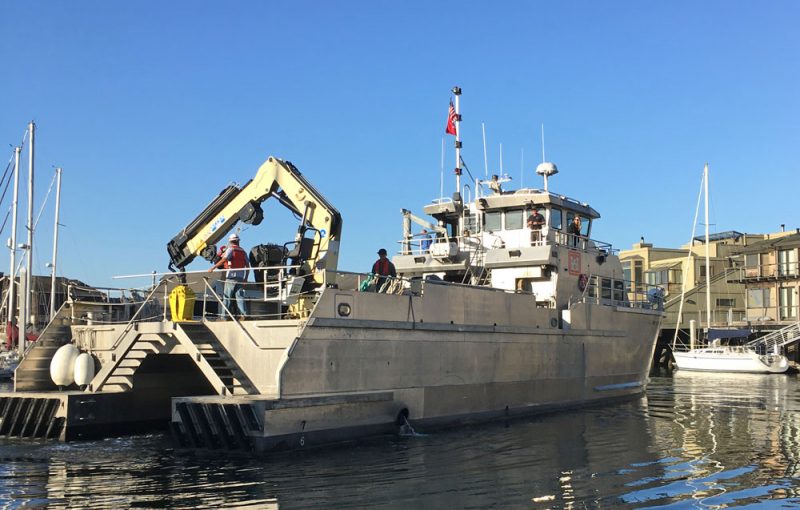
The buoys set this fall had some particular issues that needed to be addressed. For instance, XOC is a very large buoy that required a very large anchor. A large anchor is expensive, and shipping a large and heavy anchor proved to be, not surprisingly, very expensive as well. Scott Easom thought there had to be a better solution than incurring the expense of buying and shipping a huge anchor to his shop. He started searching for a reasonable replacement. He found one just down the street from his shop. Scott remembered seeing an old railroad car wheel lying around at KKMI and asked the folks at KKMI if they would mind donating it to a good cause, namely as an anchor for XOC. KKMI agreed, and the railroad car wheel was transported to Scott’s shop and deployed as the anchor for XOC.
All the buoys set this fall, including XOC, were set with one-and-a-half-inch chain from the anchor to a swivel that would sit several feet above the anchor. One-inch chain was used from the swivel to the buoy. The upgraded chain stock should ensure that the buoys stay on station for a number of years, especially buoys like #4 (Knox), which is buffeted by very strong currents.
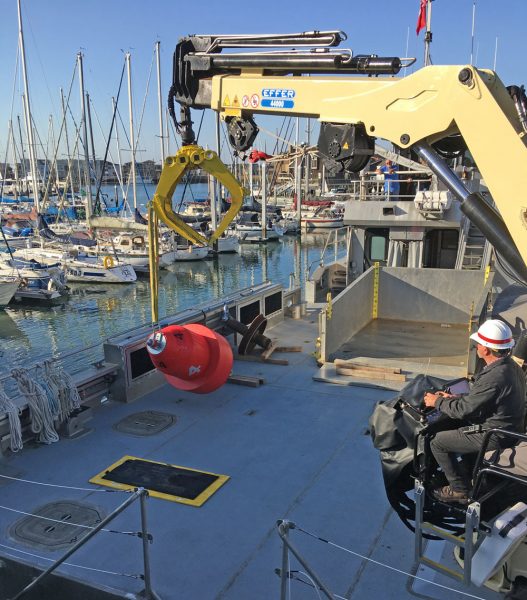
The YRA would like to thank Bill Claussen, the YRA buoy chairman, for coordinating the efforts between the YRA and Scott Easom, and for creating a sponsorship program. We’d also like to thank Scott Easom for his expertise in rigging the buoys, and Captain Kixon Meyer and his crew from the Army Corps of Engineers for their invaluable help in setting the new buoys.
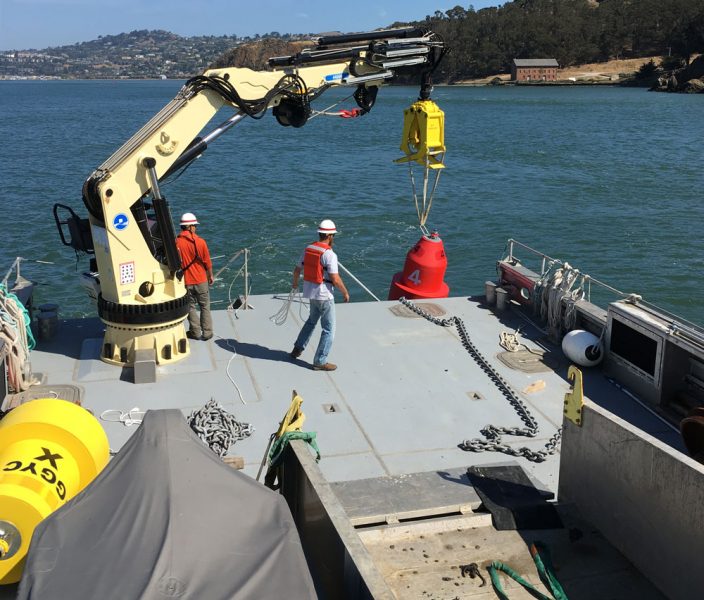
It should be noted that the Army Corps of Engineers’ mandate to maintain the waterways on the Bay was created in 1942. According to the Army Corps’ website, “In June of that year, Admiral Chester Nimitz, recently appointed Commander in Chief, Pacific Fleet, was on his way from Hawaii to Washington DC via San Francisco. While landing in San Francisco Bay, his seaplane struck floating debris. The bottom of the aircraft was ripped open and it capsized. Admiral Nimitz was able to scramble to safety without serious injury, but the pilot was killed. Shortly after that incident, the Chief of Engineers directed the Corps’ San Francisco District to begin a hazard collection program in San Francisco Bay, a mission that continues to this day.”
Our biggest thanks, from the YRA and all the sailors who use the YRA marks, goes out to our new buoy sponsors. KKMI is sponsoring #6, and therefore #6 will be known at KKMI 6 and will feature the KKMI logo. Svendsen’s Bay Marine is sponsoring the Circle buoys XOC, F, and G. These buoys will be known as the Svendsen Circle Buoys and will display the Svendsen’s Bay Marine logo. So, when you round these buoys say a thank you to their sponsors, Easom Rigging and the Army Corps of Engineers. You can’t race without a playing field.

